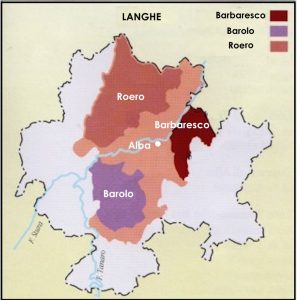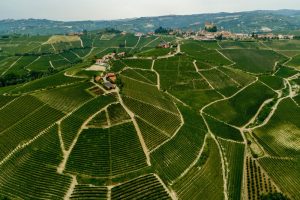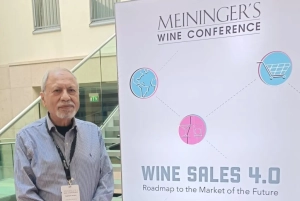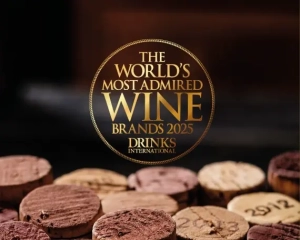Blog: Barbaresco vs. Barolo and the Brag Factor

Barolo and Barbaresco are both docg wines produced in Piedmont with the same grape, Nebbiolo. Named after the two villages and also including a few villages surrounding them, the villages are about fifteen Kms apart. There is also another appellation Nebbiolo DOC which includes these areas and more.
DOCG Barolo consists of 11 villages- Barolo, Castiglione Falletto, Serralunga d’Alba, Cherasco, Diano d’Alba, Grinzane Cavour, La Morra, Monforte d’Alba, Novello, Roddi and Verduno whereas Barbaresco is produced in much smaller area-on the right bank of River Tanaro in the nearby south-east of Alba in only 3 villages- Barbaresco, Neive and Treiso, and San Rocco Seno d’Elvio, a district of Alba.
The Barolo production area is three times larger than Barbaresco, with a total production of about 15 million bottles compared to 4.5 million bottles of Barbaresco. Barolo and Barbaresco are two thoroughbreds but with different characteristics due to the difference in soils.
Also Read : Sorì San Lorenzo- Barbarescan icon from GAJA
Barolo, the wine of kings
With the origins of Barolo going back to the early nineteenth century, it had been historically named as the wine for Kings and King of wines served by the royalty and kings. This helped the wine establish itself as the most prestigious of Italian wines while Barbaresco was introduced by the end of the nineteenth century. But with winemakers of Barbaresco taking keen interest in improving the quality and finesse of this wine aptly known as the Queen of wines because of its lighter body, feminine character and nazakat (delicate nature) brought up the quality.
Also Read : The World of Gaja: Sperss in Serralunga turns 30
Angelo Gaja, Prince of Piedmont
Angelo Gaja names as the Prince of Piedmont by the Decanter magazine about 30 years ago, is known to have carried on with the legacy from his father Giovanni Gaja who worked relentlessly to take Barbaresco to another level but not compete with Barolo directly as they were producing Barolo as well.

‘Although the grape is the same, Barolo rewards opulence and richness. Barbaresco is a champion of elegance and finesse and is much closer in the olfactory expression to Pinot Noir. It has the same capacity as Barolo for maturation, and ageing’, says Angelo though the docg appellation rules require Barolo to age for 3 years compared to 2 years for Barbaresco.
Also Read : Angelo Gaja: Driving Italian Wines was not easy
I find Barbaresco lighter bodied, with silkier tannins which are smoother on the palate and the wine more feminine and brighter on the mid palate, whereas Barolo is fuller and more powerful with stronger tannins that require proper matching with food like beef steak or game, to tame the velvety tannins.
Barbaresco can get better
Angelo Gaja gives and interesting comparison to prove his point that Barbaresco can even be better with proper viticulture and winemaking. In recent decades, Barbaresco had been Barolo’s favourite workhorse of Barolo. Being from the same grape, it did not steal the stage from the big brother Barolo, having a reverence and the fear of challenging Barolo’s supremacy. In more recent times, however, the workhorse has grown and has realized the awareness of its means and value.
Also Read : Chianti Classico announces Terroir-based Sub-zoning UGA
Barbaresco continued to help the big brother Barolo and accepted its role as a workhorse. However, as it neared the finish line, it started to like the challenge and the race and with a sprint near the finish line even won the race. Barolo and Barbaresco will always have this race as an open, fair, honest competition played at home and will contribute to make Piedmont’s red wines improve further in quality, says Angelo.
Gaja shares with a sense of satisfaction that in 2024, an aggregation of judgement scores of Italian wine guides (Veronelli, Vitae, Bibenda and Cernilli), published by the Gentleman magazine which tasted 3115 Italian wines, placed Gaja Barbaresco Sori’ Tildin, a single vineyard Barbaresco as the top Italian wine, followed closely by Sassicaia and a Barolo at the 3rd spot.

According to Marvin Shanken, Editor of Wine Spectator who has known Gaja for over 40 years, he is charismatic with a bold personality and always obsessed with convincing connoisseurs that Barbaresco wines deserved a place on the table with classic wines of the world. He can take pride today that he has achieved his purpose and can rest knowing that he has achieved his goal. Imported in India by Sonarys, Gaja wines are well represented In both the top Barbaresco and Barolo wines of the world.
Also Read : Gaja Back to Barbaresco Roots
Angelo has often shared with me that Barbaresco wines are the most versatile red wines that can pair well even the chicken dishes-but not so Barolo. The top Barbaresco wines can go as high as $813 a bottle for Gaja Sori Tildin 2020 vintage (Source- Wine Searcher). Sori San Lorenzo is listed even higher at $863. (Global average price-ex-tax). Gaja Sperss Barolo lists for $567 for the same vintage.
Barolo and the Bragg Factor
Angelo Gaja is credited universally as the producer who has put Barbaresco on the world map. Unfortunately, not so in India where Barolo is not a docg appellation but a top Italian Brand. It is often served at parties and banquets where people gulp wine with snacks, as the top Italian wine, where Barbaresco would fare better and also cheaper by 25-30%; and that counts what with the excruciatingly painful taxes. Besides, even though Angelo claims Barbaresco can age as well as Barolo, the former is approachable earlier, say 4-5 years after the vintage, whereas Barolo should be opened minimum 8 years ago after the vintage on the bottle and stored well. Every time, one needs to be reminded that they are both produced from the same gap but with different characteristics.
Bragg Factor
Brag Factor implies how much one can boast in private or public about his or her affluence and knowledge about wine. The aspirational drink is often used as a way of impressing friends and foes alike and is akin to showing off that the person has “arrived”. Many people may not be aware of Gaja as a top brand (label) of Piedmont, but would take pride in serving or drinking Barolo as the top Italian wine.
Next time you want to order the two wines, think of the occasion and whether you want to serve the King of wines or the Queen.
What are your views? Please share in your comments.
Subhash Arora




